19.63.040 Building massing and articulation.
A. Purpose.
1. To employ facade articulation techniques that reduce the perceived scale of large buildings and add visual interest from all observable scales.
2. To create clear and welcoming building entries.
B. Exemption. Buildings with less than 60 horizontal feet of facade are exempt from this section.
C. Facade Articulation. Nonresidential, mixed-use, and multifamily residential buildings must include facade articulation features at designated maximum intervals to create a human-scaled pattern. This standard applies to applicable building facades and other applicable building elevations facing parks, containing primary building entrances, and adjacent to lower intensity zones. Alley-facing building elevations not adjacent to a lower intensity zone are exempt.
1. The maximum horizontal length of intervals is:
a. MMU zone: 50 feet.
b. HM and LM1 zone (where applicable): 60 feet.
c. Buildings in all other applicable zones: 30 feet.
2. At least three of the following articulation features must be employed in compliance with maximum interval standards in subsection (C)(1) of this section:
a. Use of windows and/or entries.
b. Use of weather protection features.
c. Use of vertical piers/columns (applies to all floors of the facade, excluding upper-level stepbacks).
e. Change in building material, siding style, and/or window pattern (applies to all floors of the facade, excluding upper level stepbacks).
f. Vertical elements such as a trellis with plants, green wall, or art element that meet the purpose of the standard.
g. Providing vertical building modulation of at least 12 inches in depth if tied to a change in roofline per subsection (F) below or a change in building material, siding style, or color. Balconies may be used to qualify for this option if they are recessed or projected from the facade by at least 18 inches. Juliet balconies or other balconies that appear to be tacked on to the facade will not qualify for this option unless they employ high-quality materials and effectively meet the purpose of the standards.
h. Other design techniques that effectively reinforce a pattern of small facades compatible with the building’s surrounding context.
DEPARTURES will be considered, provided they meet the purpose of the standards and the design criteria in subsection (D) below. For example, a departure may propose a design with only two articulation features instead of three or the articulation features exceed the maximum articulation interval.

The left image uses window patterns, awnings, and roofline modulation. The photo example to the right also includes window patterns and weather protection along with brick vertical piers to articulate the facade. The lower example illustrates how a multi-tenant retail building can successfully be articulated (windows, weather protection, vertical building modulation, and roofline changes). 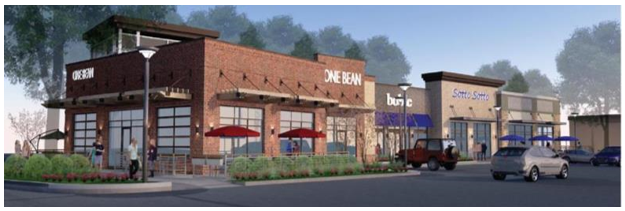
|
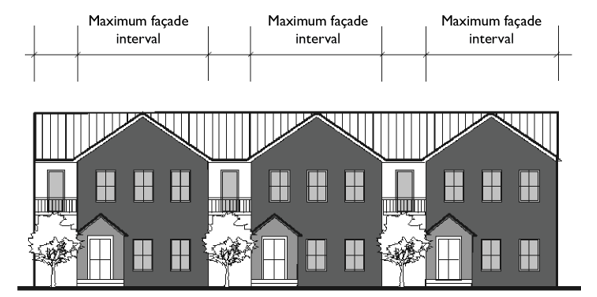
Below examples (except bottom right image) use a combination of vertical building modulation, window patterns, material changes, and roofline modulation. 

|
D. DEPARTURE Criteria Associated with Articulation Standards. Proposals must meet the purpose of the standards. The following criteria will be considered in determining whether the proposed articulation treatment meets the purpose:
1. Consider the type and width of the proposed articulation treatment and how effective it is in meeting the purpose given the building’s current and desired context (per Anacortes’s comprehensive plan).
2. Consider the applicable block frontage designation. Undesignated block frontages warrant more flexibility than block frontages designated as mixed or landscaped.
3. Consider the size and width of the building. Smaller buildings warrant greater flexibility than larger buildings.
4. Consider the quality of facade materials in concert with doors, windows, and other facade features and their ability to add visual interest to the street from a pedestrian scale and more distant observable scales.
E. Maximum Facade Width. Building facades and other building elevations facing lower intensity zone edge must include at least one of the following features to break up the massing of the building and add visual interest. This standard applies to applicable building elevations wider than 100 feet (wider than 150 feet in the MMU zone).
1. Provide vertical building modulation at least six feet deep and 15 feet wide. For multi-story buildings, the modulation must extend through at least one-half of the building floors.
2. Use of a contrasting vertical modulated design component featuring all of the following:
a. Utilizes a change in building materials that effectively contrast from the rest of the facade.
b. Component is modulated vertically from the rest of the facade by an average of six inches.
3. Facade employs building walls with contrasting articulation that make it appear like multiple distinct buildings. To qualify for this option, these contrasting facades must employ all of the following:
a. Different building materials and/or configuration of building materials.
b. Contrasting window design (sizes or configurations).
4. DEPARTURES to subsections (E)(1) through (E)(3) of this section will be considered, provided the design meets the purpose of the standards. Supplemental consideration for approving alternative designs:
a. Width of the facade. The larger the facade, the more substantial articulation/modulation features need to be.
b. Block frontage designation. Storefront designated block frontages warrant the most scrutiny while undesignated streets warrant more flexibility.
c. The type of articulation treatment and how effective it is in meeting the purpose given the building’s context.

Less than 100' wide: Meets standard. |
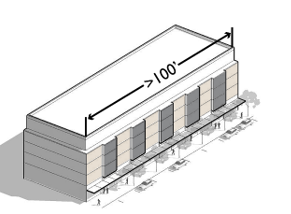
More than 100' wide: Does not meet standard. |

Building incorporates a courtyard along the facade (technique No.1 noted above) to effectively break it up into smaller components: Meets standard. |
|
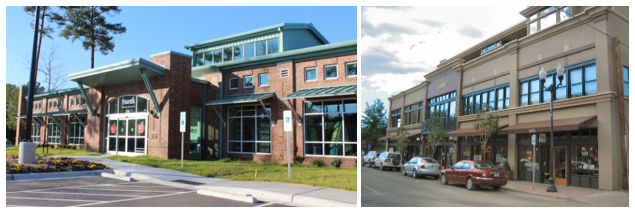
The left building uses technique No. 1 (vertical building modulation at least six feet deep and 15 feet wide). The right building uses technique No. 2 (contrasting vertical modulated design component). Both examples are effective in breaking up the perceived scale of the building and adding visual interest. |
|
F. Roofline Modulation. Roofline modulation is not required on all buildings. However, it can be used as one of the facade articulation features in subsection C of this section. In order to qualify as an articulation feature, rooflines must employ one or more of the following:
1. For flat roofs or facades with horizontal eave, fascia, or parapet, the minimum vertical dimension of roofline modulation is the greater of two feet or 0.1 multiplied by the wall height (finish grade to top of the wall) when combined with vertical building modulation techniques described in subsections above. Otherwise, the minimum vertical dimension of roofline modulation is the greater of four feet or 0.2 multiplied by the wall height.
2. A pitched roofline or gabled roofline segment of at least 20 feet in width. Buildings with pitched roofs must include a minimum slope of 5:12 and feature modulated roofline components at the interval required per the applicable standard above.
3. A combination of the above.
DEPARTURES will be considered, provided the roofline modulation design effectively reduces the perceived scale of the building and adds visual interest.

Roofline modulation examples for flat roofs. 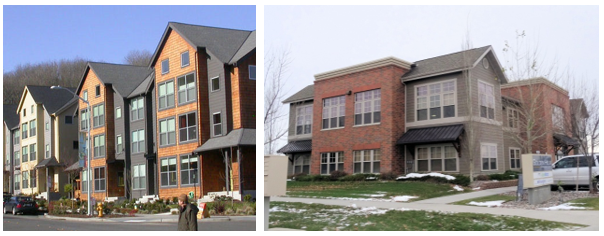
The left building illustrates a pitched roof example and the right building includes a combination of flat and gabled rooflines. |
(Ord. 3040 § 2 (Att. A), 2019)